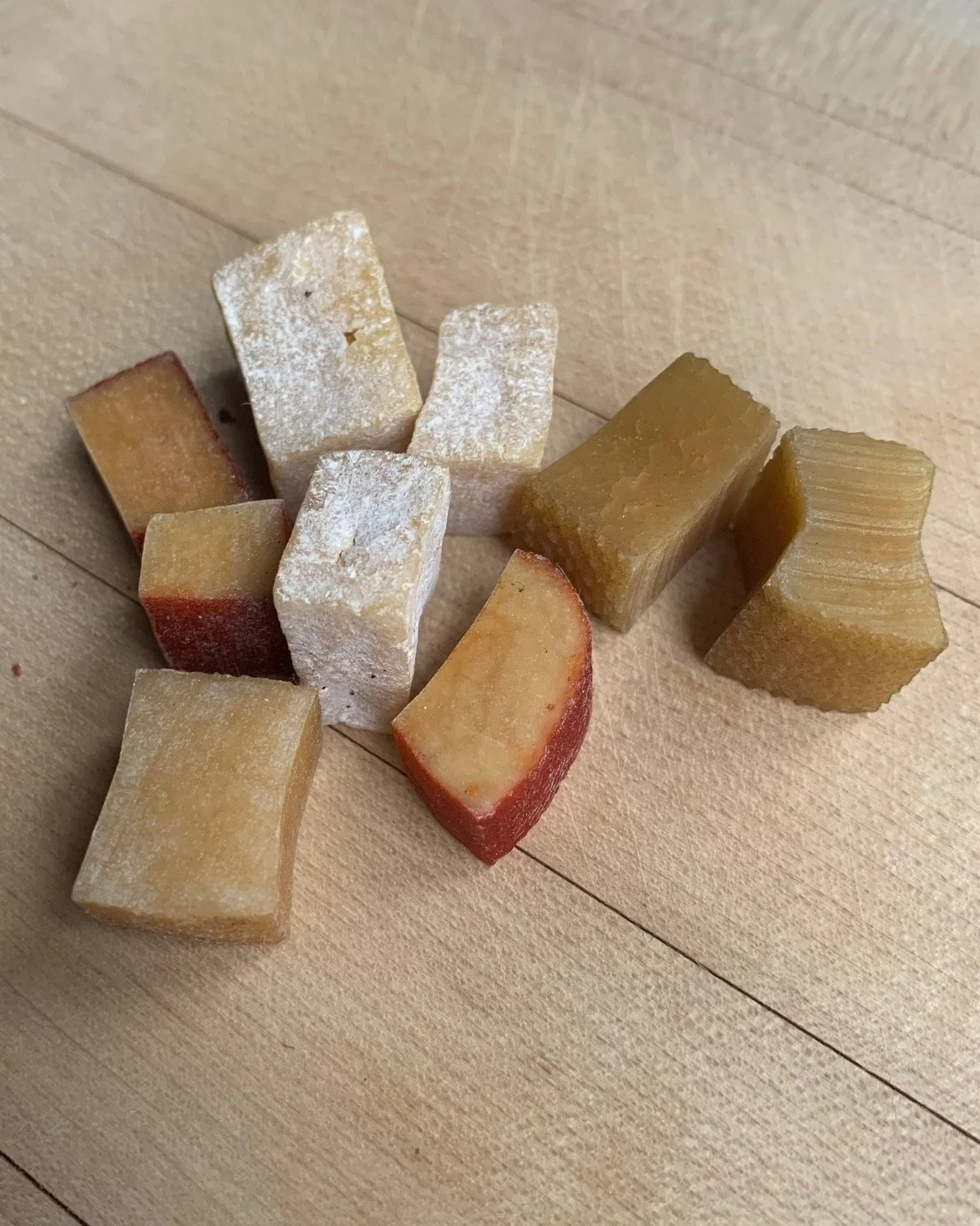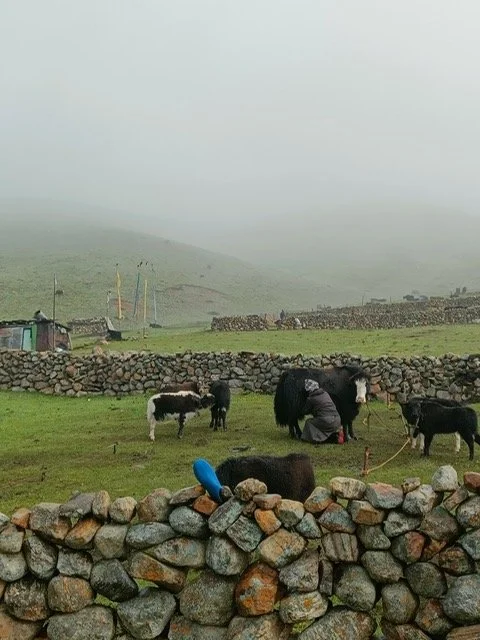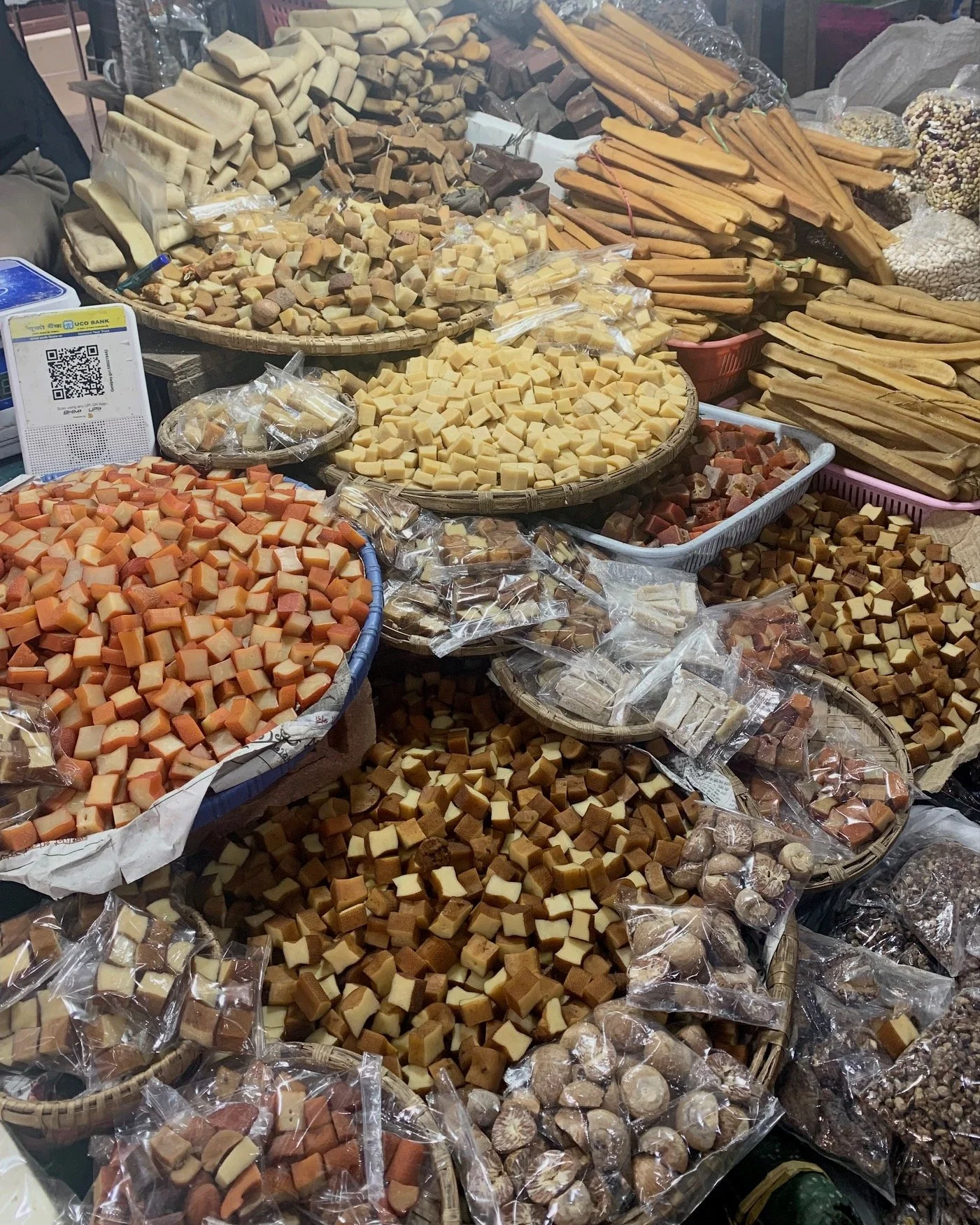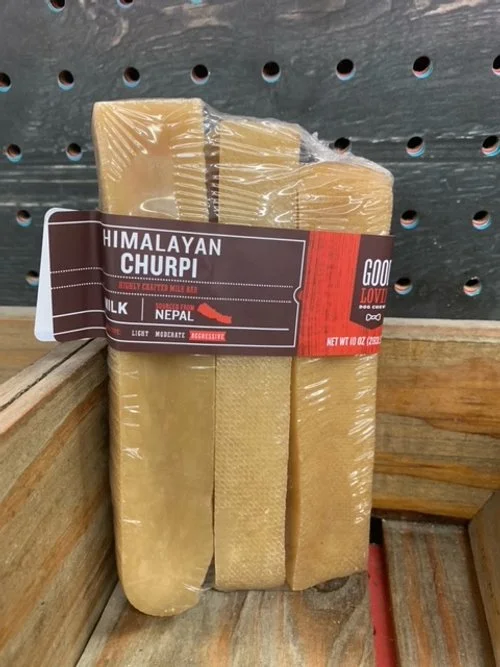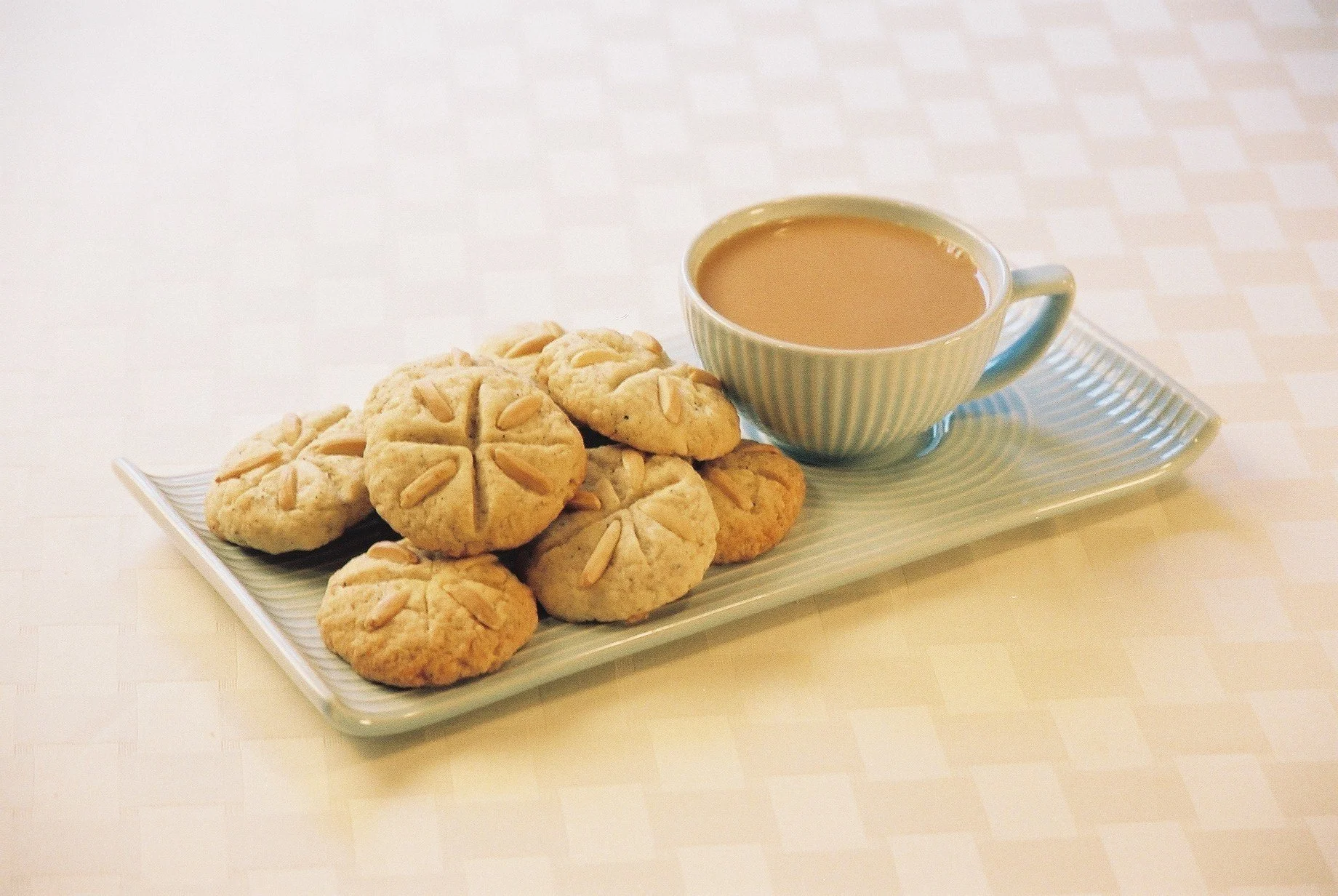Chhurpi: The Nutrient-Rich Himalayan Yak Cheese
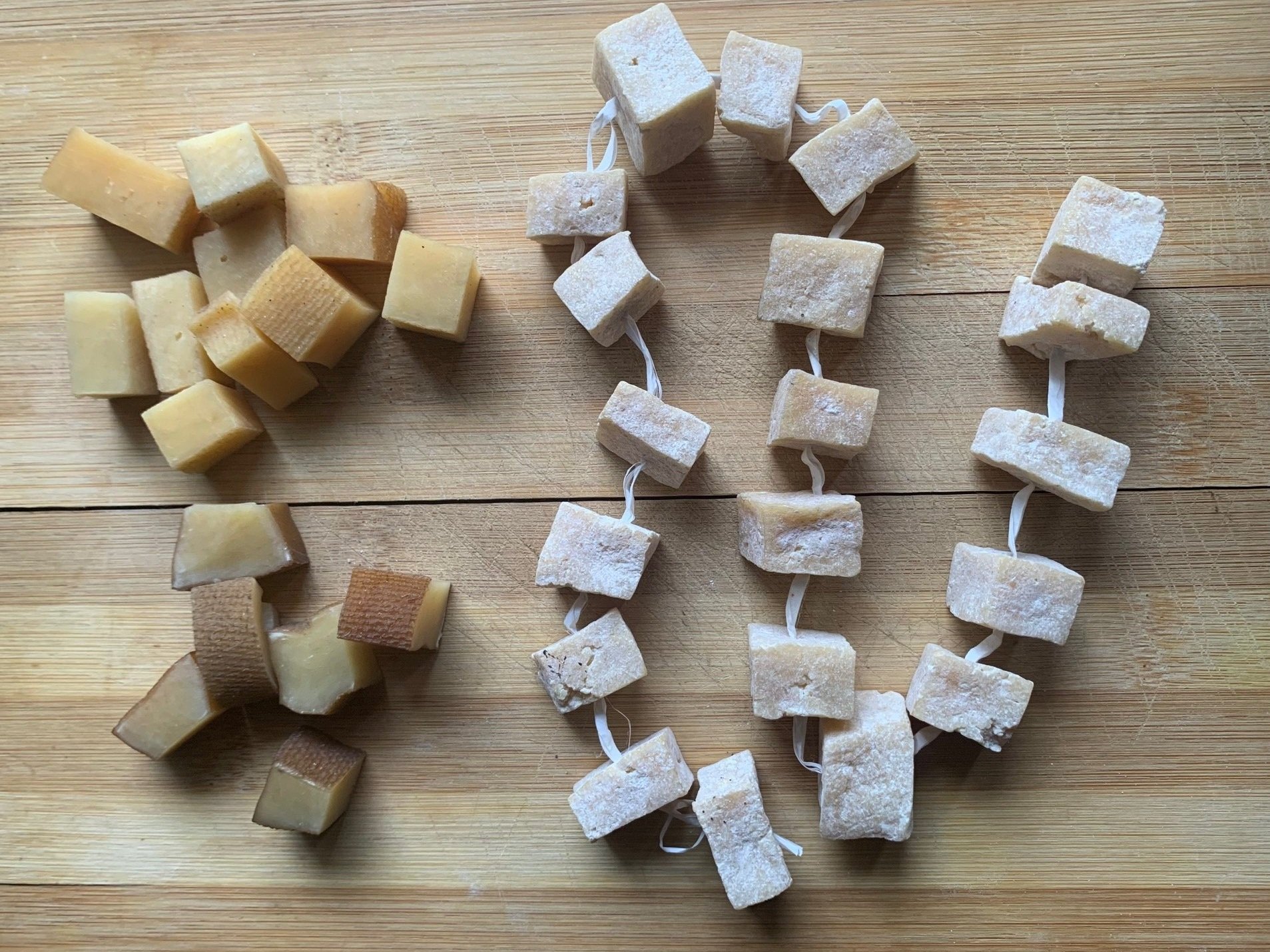
Brandon Langston takes us high in the hills of the eastern Himalayas, where yak herding is a way of life, and where a hard yak cheese is a necessary adaptation to harsh conditions — a way to preserve extra milk that would spoil before it could be consumed or sold.
It was our last night in Darjeeling. My travelling companion, Drishti, and I were near the taxi stand, walking past butcher shops and bakeries, when she stopped at a small wooden kiosk. “Yak cheese,” she said pointing at the woven basket of individual cubes, and zip loc bags with filled with a handful and hanging from the sides.
It's called chhurpi, she explained. It’s a hard cheese made by yak herders in the mountains. They dry it, by smoke or breeze, until it's so hard and so dense that it takes an hour to consume a single piece.
“Just pick one," Drishti advised. "In case you don’t like it."
Chhurpi is a hard, dry yak cheese, primarily made in Nepal.
The flavour is mild; milky, faintly sweet, with a whisper of smoke in the background.
The texture required an adjustment. Back home in Pennsylvania, “hard cheese” meant nothing more rigid than crumbly parmesan. But this was a pleasurable adjustment, like rolling down the car window at just the right altitude on the climb from Siliguri to Darjeeling, when the air shifts — suddenly cool — and you pull down your sleeves to enjoy it.
The flavour was mild; milky, faintly sweet, with a whisper of smoke trailing in the background. It didn’t assert itself or overwhelm the senses. It simply stayed there like a friend as the long hour passed.
Writers often claim yak herders chew on chhurpi like gum, but this is misleading. Chhurpi cannot simply be chewed unless it is soaked overnight, softening into something rubbery and easily eaten. Dry chhurpi has no give. It cannot be bitten into; only gnawed as each microscopic layer is rehydrated with saliva, scraped away by your teeth, and the cycle repeated.
Despite discovering chhurpi in Darjeeling, it is primarily made in neighbouring Nepal and just north in Sikkim, that small indentation in the Himalayas above the Darjeeling Hills.
In Gangtok, Sikkim’s capital, I sought to learn about chhurpi from the source. Luckily, my local contact, Jamyang Bhutia, informed me that an elder from a herding community in North Sikkim’s Muguthang Valley was already in town. Jamyang called him Uncle Tsogyal. He spoke only Tibetan, so she offered to introduce us and translate at her Gangtok homestay – a beautifully Sikkimese space called Dzomo Homestay.
Uncle Tsogyal is a Dokpa, part of an ethnic group from Tibet. Like all yak herders, the Dokpas follow their animals to higher elevations in spring and summer to escape the heat, then descend for autumn and winter. For generations, the Dokpas crossed freely between Tibet and Sikkim — migrating, trading, visiting family. It ended after China invaded Tibet, the border was sealed, and both the Dokpas and their yaks who happened to be in Sikkim found themselves stuck there, instantly cut off from half of their homeland.
Yak herders follow their animals to higher elevations in spring and summer to escape the heat, then descend for autumn and winter.
Chhurpi is a necessary adaptation to harsh conditions; a way to preserve extra milk that would spoil before it could be consumed or sold.
Yak herding in the eastern Himalayas is a tough life that demands endurance in the cold, thin air of the high altitudes far from proper towns. Chhurpi is a necessary adaptation to these conditions. It’s a way to preserve extra milk that would spoil before it could be consumed or sold.
The process, Uncle Tsogyal explained, is long but simple.
First, fresh yak milk is heated, and the butter is churned out. The leftover milk is then reheated and curdled not with acid, as I had read online, but with reserved curd from a previous batch.
“You don’t add lemon juice?” I asked.
“No,” he said. "There are no lemons. Just curd. It is enough.”
The curds are removed, shaped, and squeezed under heavy rocks or a mechanical press. At this stage, the soft chhurpi can be eaten immediately. But to make the hard chhurpi, the kind that lasts for months, the cheese is left to dry — either in the cool mountain air for weeks or smoked over a gentle fire for a few days. The hardened chhurpi is then sold in sticks or pre-cut into cubes with a heavy blade. In a cool, dry place it can stay preserved for years.
Chhurpi is common in markets in Gangtok, and Darjeeling.
The best and most expensive is dudh chhurpi, easily identified by its pale colour flecked with spots of white milky powder.
To make the hard chhurpi, the cheese is left to dry— either in the cool mountain air for weeks or smoked over a gentle fire for a few days.
In Gangtok’s Lal Bazaar, chhurpi is abundant. There’s plenty of the tan, smoked variety. But the best—and the most expensive—is dudh chhurpi. It’s easily identified by its pale colour flecked with spots of white milky powder, and it has the creamiest flavour of any variety.
The cheaper kinds are even more common throughout Sikkim. Often their rinds are dyed and, according to my guide in Pelling, are made with cow’s milk and sometimes cut with starch. This was evidenced by the faint aftertaste—something between dehydrated potato and cardboard.
Yak milk, by contrast, is full-bodied because it contains more of everything: more fat, more protein, more sugar, more vitamins. But yaks produce less milk than cows, so they are often crossbred together. The hybrid offspring go by different names across the Himalayas, but in Sikkim, the males are called Dzo and the females Dzomo. Dzomo yield more milk, needn’t migrate quite as high, and are more resistant to certain diseases.
“They’re also prettier,” Jamyang said with a grin. “That’s why I named my homestay Dzomo, not Dzo.”
In India today, yak herding is declining under the strain of climate change and the double-edged sword of economic opportunity. Warming seasons are disrupting traditional migration patterns. Across the region, herders echo the same concern.
Yet again, those least responsible for climate change are the ones bearing its harshest consequences.
At the same time, modern roads, schools, and economic expansion has made education more accessible than ever. Children sent to school are abandoning herding for the comforts of city life and wage jobs. Parents continue sending them anyway, wanting their kids to have those opportunities and make their own choices. Migratory Himalayan pastoralism, which demands extensive intergenerational knowledge and consistent physical labour, is rarely the more appealing choice. For this reason, in Arunachal Pradesh alone the number of herding families has plummeted from 800 to just 200 in the last decade.
Nevertheless yak herding and chhurpi’s survival in the subcontinent has been ensured through some creative programs. In Arunachal Pradesh, for instance, the National Research Center on Yak is working to breed hybrids that won’t require migration at all. In Nepal, some communities have pivoted to tourism and launched an annual Yak Festival introducing visitors to their traditional culture. There’s also a growing industry for exporting massive quantities of pure and mixed-milk chhurpi from Nepal to the U.S.— marketed not for human consumption, but as high-end dog chews.
In America, chhurpi is sold as a dog chew.
Remunerative though it is, an unfortunate cost of this export industry is that it introduces chhurpi to Americans as ‘just’ a dog bone stripped of its human value. Encountering chhurpi in the subcontinent forces you to appreciate it for what is: a cheese so well preserved it can be sold at roadside stalls, can keep you (as it did me) occupied for half of a four hour hike, and which loses none of its flavour through the last bite. (At the very end, you can bite it.)
Churpi is a food so environmentally derived, so necessary, that it’s as indispensable to Himalayan life as the yak itself.
Brandon Langston is an American historian and writer. Follow him on Instagram at @brandonraylangston
Photos courtesy the author, Chopel Dorjee of the trekking tour company called Enroute West Sikkim.
ALSO ON GOYA
